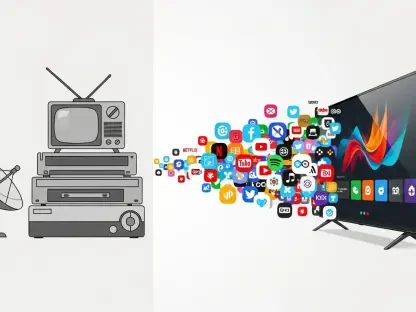The rise of AI avatars, also referred to as “digital humans,” is set to significantly alter the landscape of customer service and network operations within the telecom industry. These advanced virtual personas offer more engaging and human-like interactions compared to traditional chatbots, promising to enhance overall customer satisfaction and streamline processes.
Enhanced Customer Satisfaction and Sales
Improved Customer Interactions
Research highlights that digital humans provide higher levels of customer satisfaction. Customers engage in more natural and forgiving conversations, leading to longer and more productive interactions. Unlike traditional chatbots that often result in brief and mechanical exchanges, AI avatars facilitate a more comfortable and human-like conversational flow. Users tend to appreciate this kind of interface, feeling as if they are talking to a real person rather than a machine, which significantly enhances the overall customer experience. Additionally, these virtual agents are capable of understanding and responding to a wider range of inquiries more efficiently, thus reducing the frustration often associated with automated customer service.
The empathetic and intuitive nature of digital humans also contributes to increased customer loyalty. Customers are more likely to return when they have positive, memorable interactions with the service, making it a critical factor for telecom companies aiming to retain their competitive edge in an increasingly saturated market. By ensuring that interactions are pleasant and efficient, AI avatars create a win-win scenario for both the company and the customer, ultimately leading to enhanced customer retention rates.
Increased Sales Likelihood
Interactions with AI avatars not only improve the perception of product quality but also increase the likelihood of purchases. This human-like interface can drive sales and elevate the customer experience. Customers are more inclined to make purchasing decisions when they feel their needs are understood and addressed in a personalized manner. Digital humans are adept at creating such connections, using sophisticated algorithms to analyze customer preferences and behavior. This enables them to provide tailored recommendations and promotions, which in turn, boosts the potential for sales.
Moreover, the engaging nature of AI avatars can effectively upsell and cross-sell products, further driving revenue streams. For instance, if a customer is inquiring about a mobile plan, the digital human can seamlessly suggest complementary services such as device insurance or additional data packages, based on their browsing history and previous interactions. This personalized approach helps in building trust and assuring customers that the company values their individual needs and preferences. As a result, customers are more likely to make repeated purchases and explore more of the company’s offerings.
Natural and Intuitive Interaction
Conversational AI Capabilities
Digital humans excel in delivering natural conversations. Users appreciate the conversational flow, which is more akin to interacting with human customer service representatives. This aspect is particularly valuable in the telecom sector, where clear communication and quick resolution of issues are paramount. The advanced conversational AI capabilities of digital humans allow them to understand context, manage the flow of dialogue, and even interpret the nuances and emotional tones of the interaction. This makes the conversation more dynamic and fulfilling for users as they find themselves engaging in a seamless dialogue rather than a disjointed sequence of questions and answers.
The ability to simulate human-like conversation is not just limited to understanding verbal cues; it also extends to non-verbal cues such as facial expressions and gestures, which are crucial for generating a truly immersive experience. These non-verbal cues play a significant role in making the interaction feel more genuine and organic, further bridging the gap between human and machine communication. As a result, users are often more patient and willing to converse with digital humans, which improves customer satisfaction and facilitates smoother problem resolution.
Handling Complex Queries
AI avatars are better equipped to manage complex questions and issues due to their advanced AI capabilities, further enhancing user engagement and trust. They can analyze and comprehend complex queries with remarkable accuracy, thanks to their robust machine learning algorithms that constantly evolve and improve over time. This makes them suitable for dealing with a wide range of issues, from basic account inquiries to more intricate technical problems. Consequently, the reliance on human agents is reduced, freeing them to focus on tasks that require a higher level of expertise.
The efficiency of digital humans in handling complex queries not only increases operational efficiency but also significantly reduces wait times for customers. Faster and more accurate responses to inquiries lead to higher customer satisfaction and a more streamlined service experience. Moreover, the advanced analytics and reporting capabilities of AI avatars allow telecom companies to identify common issues and pain points, enabling them to proactively address these areas and improve overall service quality. By continuously learning and adapting to new data, digital humans are poised to offer increasingly specialized and proficient support in the years to come.
Versatility in Various Roles
Digital Concierges
AI avatars function efficiently as digital concierges, offering tailored and high-end service experiences similar to those in brick-and-mortar stores. In this role, they are able to provide personalized assistance, guiding customers through various options and helping them make informed decisions. This can include suggesting suitable products, providing detailed information about services, and even assisting in the setup and use of telecom devices. The concierge service offered by digital humans mimics the expertise and attentiveness of in-store sales personnel, but with the added convenience of being available around the clock.
The ability to offer such comprehensive and sophisticated service remotely is a game-changer for the telecom industry. Companies can expand their service reach without the need for physical store presence, effectively optimizing resources and reducing operational costs. Moreover, the seamless and continuous service provided by digital concierges ensures that customers receive consistent and high-quality assistance anytime they need it. This enhances customer satisfaction and strengthens the overall brand reputation, making digital humans an invaluable asset in the competitive telecom market.
Generating Training Content
The versatility of digital humans also extends to creating training videos, automating processes typically requiring human actors, and reducing production time and costs. AI avatars can generate high-quality, consistent training materials rapidly, which can be updated and disseminated with minimal effort. This efficiency is particularly beneficial in the fast-paced telecom industry, where frequent updates and new developments require constant employee training. By leveraging digital humans for training purposes, companies can ensure that their staff is always up-to-date with the latest knowledge and skills.
Furthermore, the use of AI avatars in training can also improve engagement and retention among employees. Interactive and visually engaging training modules created by digital humans are more likely to capture employees’ attention and facilitate better learning outcomes. The ability to simulate real-life customer interactions and provide instant feedback makes the training process more practical and effective. This not only improves employee performance but also translates to better customer service, as well-trained employees are more capable of handling customer inquiries and issues efficiently.
Addressing Current Limitations
Overcoming the Uncanny Valley
One of the challenges AI avatars face is the “uncanny valley” effect, where avatars appear almost but not perfectly human-like. This phenomenon can create a sense of unease and discomfort among users, potentially undermining the effectiveness of digital humans. Continuous advancements in technology aim to resolve this issue by enhancing the realism and appeal of these avatars. Efforts are being made to improve facial expressions, voice modulation, and other subtle nuances that make interactions feel more natural and less robotic.
Developers are also focusing on creating a diverse range of avatar designs to appeal to different user demographics. By offering a variety of visual styles and personas, companies can cater to individual preferences and reduce the likelihood of triggering the uncanny valley effect. The goal is to create AI avatars that not only look and sound natural but also evoke positive emotional responses from users. As these technological improvements continue to unfold, the gap between human-like appearance and user acceptance is expected to narrow significantly, making AI avatars more approachable and effective in their roles.
Language and Accuracy Challenges
Addressing language barriers and ensuring the accuracy of information to prevent “hallucinations” remain focus areas for improvement. AI avatars need to be proficient in understanding and conveying information across multiple languages and dialects to be truly effective in a global market. This requires the continuous refinement of natural language processing (NLP) capabilities to handle various linguistic nuances and regional differences accurately. Ensuring that digital humans can provide precise and relevant information without generating misleading or erroneous answers is critical for maintaining user trust.
Additionally, developers are working on incorporating real-time language translation capabilities, which would enable AI avatars to communicate seamlessly with users across different languages. This feature can enhance accessibility and inclusivity, making digital humans valuable assets for multinational telecom companies. The ability to accurately interpret and respond to complex queries in various languages will significantly elevate the overall user experience, ensuring that customers from diverse backgrounds receive consistent and high-quality service.
Customization Preferences
Boosting Trust and Connection
Customization of digital humans allows users to form deeper connections and trust, especially among Generation Z and Generation Alpha, who have shown a preference for personalized avatars. These younger generations, having grown up in a tech-savvy environment, are more inclined to interact with virtual personas that resonate with their individual preferences and identities. Customization options such as choosing the avatar’s appearance, personality traits, and communication styles can significantly enhance user engagement and satisfaction. When customers feel a sense of personal connection with the digital human assisting them, they are more likely to trust the information and recommendations provided.
The ability to tailor digital humans to reflect user preferences also helps create a more inclusive and relatable interaction experience. By offering diverse representation in avatar designs, companies can cater to a broader audience, ensuring that users from various backgrounds and demographics feel acknowledged and valued. This inclusive approach is essential for building strong customer relationships and fostering brand loyalty in a diverse market. As customization technologies continue to evolve, the potential for creating highly personalized and engaging user experiences with AI avatars will only increase.
Appearance and Personality Preferences
Although appearance, age, race, and accent customization options are available, these do not significantly impact trust, indicating that personalization works best on an emotional connection level. While visual and auditory customization can make interactions more appealing, the true value of digital humans lies in their ability to connect with users emotionally. This connection is fostered through empathetic communication, active listening, and understanding individual needs and preferences. By focusing on emotional engagement, AI avatars can build stronger and more meaningful relationships with customers.
The flexibility to customize the appearance and personality of digital humans also enables companies to experiment with different interaction styles and find the most effective approaches for their target audience. This adaptability ensures that AI avatars remain relevant and engaging, regardless of changing customer preferences and market trends. As a result, companies can continually refine their digital human interfaces to optimize user satisfaction and drive better outcomes in customer service and operations.
Real-World Implementations
AT&T and Network Troubleshooting
AT&T utilizes AI avatars for troubleshooting network issues, demonstrating practical applications in improving service efficiency and reliability. By integrating digital humans into their network operations, AT&T has been able to streamline the process of diagnosing and resolving technical problems. These AI avatars can promptly identify common issues, guide customers through troubleshooting steps, and provide real-time solutions. This not only enhances the customer experience by reducing wait times but also alleviates the workload on human agents, allowing them to focus on more complex and critical tasks.
The implementation of AI avatars in network troubleshooting reflects the broader trend of automation in telecom operations. By harnessing the power of advanced AI technologies, companies like AT&T are better equipped to manage the increasing complexity and scale of modern telecommunications networks. The efficiency and accuracy of digital humans in identifying and addressing network issues contribute to improved service continuity and customer satisfaction. As AI technology continues to evolve, the role of digital humans in network management is expected to expand, offering even more sophisticated and proactive support.
ServiceNow in Call Center Operations
ServiceNow enhances call center operations through AI avatars, achieving higher customer satisfaction and streamlined processes by integrating digital humans into call center environments. This integration has revolutionized the way customer inquiries are handled, enabling faster and more efficient responses. These AI avatars can manage a high volume of calls simultaneously, providing consistent and accurate information to customers. This scalability is particularly beneficial during peak times when the demand for customer service is high, ensuring that all inquiries are addressed promptly.
The use of AI avatars in call centers also allows for greater personalization of service. By analyzing customer data and interaction history, digital humans can tailor their responses to individual needs and preferences, creating a more engaging and satisfying experience. The ability to handle a diverse range of queries, from routine questions to complex issues, further enhances the overall efficiency of call center operations. With continuous advancements in AI technology, the capabilities of digital humans are expected to grow, offering increasingly sophisticated and personalized support to customers.
Future Prospects
Widespread Adoption Potential
AI avatars, backed by ongoing technological advancements, are likely to become central to customer service and operations across the telecom sector, transforming user interaction models. As companies recognize the benefits of incorporating digital humans into their service frameworks, the adoption of AI avatars is expected to rise significantly in the coming years. The ability to provide round-the-clock support, coupled with increasingly human-like interactions, positions AI avatars as valuable assets in enhancing customer experiences and operational efficiencies.
Moreover, the integration of AI avatars is not limited to customer-facing roles. These digital humans can also be deployed in various internal processes, such as employee training, data analysis, and administrative tasks, offering a comprehensive solution to streamline operations. The versatility and adaptability of AI avatars make them suitable for a wide range of applications, driving innovation and growth within the telecom industry. As the technology continues to mature, the scope of their influence will expand, revolutionizing how companies interact with customers and manage their operations.
Continuous Evolution
The emergence of AI avatars, often called “digital humans,” is poised to revolutionize customer service and network operations in the telecommunications sector. Unlike traditional chatbots, these sophisticated virtual beings provide interactions that are more engaging and human-like. This shift promises to significantly elevate customer satisfaction and enhance the efficiency of processes within the industry.
AI avatars leverage advanced technologies such as machine learning, natural language processing, and facial recognition to offer personalized, context-aware interactions. They are capable of managing a wide variety of tasks, from answering customer inquiries to troubleshooting technical issues and providing tailored recommendations. These digital personas can operate 24/7, ensuring that customers receive assistance at any time of day, thereby improving service availability and customer response times.
Moreover, implementing AI avatars can lead to cost savings for telecom companies. By automating routine tasks and managing high volumes of inquiries, these digital humans free up human agents to handle more complex issues, enhancing overall productivity. As AI avatars continue to evolve, their role in shaping the future of customer service and network operations becomes increasingly significant, marking a new era in the telecom industry.









